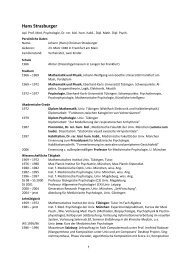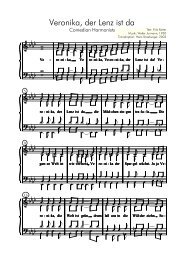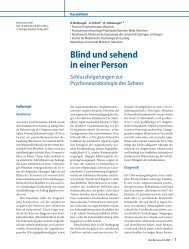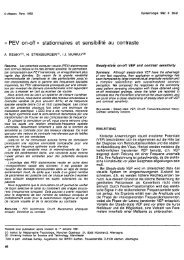Peripheral vision and pattern recognition: a review - strasburger - main
Peripheral vision and pattern recognition: a review - strasburger - main
Peripheral vision and pattern recognition: a review - strasburger - main
You also want an ePaper? Increase the reach of your titles
YUMPU automatically turns print PDFs into web optimized ePapers that Google loves.
<strong>Peripheral</strong>_Vision.doc<br />
<strong>and</strong> implemented test algorithms are briefly <strong>review</strong>ed by McKendrick (2005). Further information<br />
can be found at the Imaging <strong>and</strong> Perimetry Society’s site (http://www.perimetry.org; for example<br />
Thompson & Wall, 2008). Eisenbarth, MacKeben, Poggel, <strong>and</strong> Strasburger (2008) explored the<br />
potential of double-pulse perimetry (cf. Section 3.6.3), <strong>and</strong> showed that in age-related macular<br />
degeneration temporal thresholds are severely impaired far outside the macula, up to 20°<br />
eccentricity.<br />
A very different route has been taken for driving <strong>and</strong> pilot fitness assessment. An unpublished<br />
study of ours (Strasburger, Grundler, & Burgard, 2006) demonstrated that st<strong>and</strong>ard perimetry<br />
may not the best indicator for safe driving as it does not assess temporal sensitivity <strong>and</strong><br />
attention in the visual periphery. In the US, the Useful field of View (UFOV) test, which mixes<br />
sensory <strong>and</strong> attentional testing, has been shown to be a good predictor of driving fitness (cf.<br />
Ball, Owsley, Sloane, Roenker, & Bruni, 1993). In Europe, a test of peripheral temporal<br />
sensitivity named PP in the Vienna Test System has been found particularly predictive of driving<br />
fitness (Strasburger et al., 2006, Burgard, 2005).<br />
3.6.6 Other functions<br />
Many more visual functions have been studied with respect to whether <strong>and</strong> how they change<br />
with eccentricity in the visual field. A few are listed in Table 8, together with key references for<br />
further information.<br />
Visual Function<br />
Source<br />
Perceived locus of a target Osaka (1977)<br />
Saccadic suppression Osaka (1987)<br />
Broca-Sulzer Effect Osaka (1982)<br />
Suppression of vestibulo-ocular reflex Hood et al. (1984)<br />
Suppression of melatonin Adler et al. (1992)<br />
Table 8. Other functions studied in research on peripheral <strong>vision</strong><br />
4. Recognition of single characters<br />
In the previous chapter we have <strong>review</strong>ed visual tasks that involved unstructured or very simply<br />
structured stimuli. Characters can be considered one step further in terms of complexity <strong>and</strong><br />
might thus be more representative for capturing what is special about form <strong>vision</strong>. Surprisingly,<br />
however, it turns out that the prototypical situation of recognizing single characters at high<br />
contrast shares many characteristics with discriminating simpler forms, <strong>and</strong> it is only at lower<br />
contrast or with multiple characters that differences emerge. In the present chapter we look at<br />
the <strong>recognition</strong> of individual characters. We start with characters at high contrast where we<br />
<strong>review</strong> letter acuity <strong>and</strong> issues of <strong>recognition</strong> proper. From there we proceed to character<br />
<strong>recognition</strong> at lower contrast, <strong>review</strong>ing technical questions of stimulus presentation at low<br />
38






